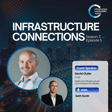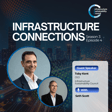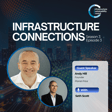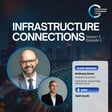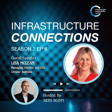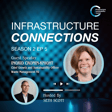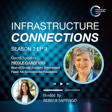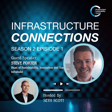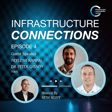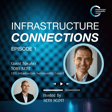Become a Creator today!Start creating today - Share your story with the world!
Start for free
00:00:00
00:00:01

Episode 5 - Taskforce for Nature Based Financial Disclosure w/ Sam Donaldson
Guest Speaker Sam Donaldson, Hub Sustainability Leader at Laing O’Rourke discusses the practice of Nature Based Financial Disclosures as a practitioner who has seen this work in the field. We also zero in on the implications it has for the future of sustainable infrastructure.
Transcript
Introduction and Theme
00:00:00
Speaker
It poses direct risk um around the ability to deliver infrastructure, even construct infrastructure, if we overexploit nature's resources.
00:00:18
Speaker
Welcome back to Infrastructure Connections, the podcast where we explore what makes sustainable infrastructure work, brought to you by the Infrastructure Sustainability Council.
Guest Introduction: Sam Donaldson
00:00:27
Speaker
I'm your host, Seth Scott, and today we'll be speaking about the task force on nature-related financial disclosure with our guest, Sam Donaldson.
00:00:36
Speaker
Sam Donaldson is the hub sustainability leader at the international construction and engineering firm Lang O'Rourke. Based in New South Wales, Australia, he has 15 years of experience developing major infrastructure and building projects to improve sustainability, environmental health, and well-being outcomes.
00:00:54
Speaker
Great. Hello, Sam. Welcome to the show. Yeah, thanks, Seth. Thanks for having me. Absolutely. So I guess the best place for us to start is from the beginning.
Lang O'Rourke's Nature Commitment
00:01:03
Speaker
um When did nature first become a strategic consideration for Lange O'Rourke?
00:01:08
Speaker
And how did that conversation evolve into a formal commitment? Yeah, well, um that stems all the way back to 2020 when we were first developing our first group sustainability strategy.
00:01:22
Speaker
And as part of that development process, we completed a materiality assessment against the us UN SDGs. And one of the outputs that came out of that assessment was to have a focus on nature.
00:01:35
Speaker
um But back in that time, you know, task force on nature, related financial disclosures, even science-based targets for nature, which we're going to talk about in more t detail throughout this conversation, were in its emerging stages. So what that practically meant ah for Langarock or for a business involved in infrastructure was unknown or uncertain at that stage.
00:02:00
Speaker
So throughout that time to to where we are now, we've actually gone through a development exercise, also a learning journey, I'd say, even for myself that I would speak about there.
00:02:10
Speaker
And we completed a number of different assessments. We developed a ah nature strategy. and We even brought in some external specialists to to help us on that process as well.
00:02:23
Speaker
And one of the commitments that we landed on and that we felt was important was to commit to the task force on nature-related financial disclosures and for the purpose of being to integrate nature into our business strategy and planning, both in the short and long term, um but also to transparently report our progress in relation to nature matters. So,
00:02:44
Speaker
That's how TNFD, and I'd like to call it TNFD throughout this conversation. Otherwise, we could be here all day because it's a bit of a tongue twister. um But that's how TNFD you know came to the table at Langer Org.
Understanding 'Nature' in Infrastructure
00:02:56
Speaker
Is there any kind of definition of what nature is? Nature is pretty broad. Is it mostly the biome? or are we also talking about rivers? Are we talking about rocks? well Or all of that?
00:03:07
Speaker
Yeah, yeah. ah It's a great question that you raised there because... you know, a lot of people's perspective on nature goes straight to biodiversity, um but it's a much more um broader a topic of a number of different sub elements under that.
00:03:23
Speaker
You know, so when we're looking at nature, it can be, you know, inclusive of the nature related resources that we draw upon. So, you know, think about you know water, think about, ah you know, even natural resources such as like sand, gravel.
00:03:39
Speaker
um It also relates to biodiversity, which we all commonly think about um nature relating to. um It also includes, you know soil quality. It's a range of different things um and it looks at both impacts and dependency.
00:03:54
Speaker
We're hearing people talk a lot about nature lately. Why has it suddenly become such a critical issue, and especially for infrastructure and business?
Biodiversity Loss and Industry Impact
00:04:03
Speaker
I think, you know, to just touch on a couple of reasons why, um without going through the the thousands of reasons why.
00:04:10
Speaker
ah Firstly, we're having biodiversity loss across the planet faster than ever before, um and the rates of decline are ah significant. um The second one is that, you know, we know that the biodiversity loss is, you know,
00:04:23
Speaker
is due to a number of different reasons. You know, climate change is is a big reason why we're having such significant rates of biodiversity loss. But the number one is from over-exploitation of um nature's resources.
00:04:37
Speaker
And that's because we heavily rely on nature's resources in the infrastructure industry, but also other industries as well. And the problem with the over-exploitation is that the demand that we have for nature's resources it can't keep up with supplying or regenerating at the rate that we need demand.
00:04:57
Speaker
And, um you know, there's other entities that have been looking at this reliance more closely, um such as the World Economics Forum. And they say that about 50% of global global GDP is reliant on nature's resources.
00:05:12
Speaker
And about 1.2 billion jobs across the planet are related on nature's resources. so you know So from a nature perspective, there's not only just the environmental issue where we're having you know significant rates of biodiversity loss across the planet, but it's also an economic one because we're over exploiting nature's resources, can't keep up with with supply and we're heavily relying on it from an industry perspective.
00:05:38
Speaker
So it's out it's now a real focal point for investors, clients, asset owners, financiers, um because they want to understand what's the level of risk that they're carrying um in their investments or the assets that they own, both over in the short term and the longer term.
00:05:58
Speaker
you know So because of that, that's the reason why we've seen global frameworks such as the TNFD be established. um And that's the reason why there's a lot of talk and conversation around how we can shift that curve and that trend um that's happening across the planet.
00:06:14
Speaker
think that's a pretty good introduction to where we're getting involved
Understanding TNFD Framework
00:06:18
Speaker
in this. um So what is the TNFD and how does it relate to broader sustainable reporting?
00:06:25
Speaker
Yeah, so yeah um TNFD is is a global framework. it's it's It's been established so that businesses can identify, assess, disclose their business-related impacts and dependencies on nature.
00:06:42
Speaker
um And it helps businesses identify those impacts and dependencies, but also helps investors, asset owners, ah financiers understand, you know you know, and make smarter decisions um around where they're going to actually outlay um their capital in businesses.
00:07:01
Speaker
um The TNFD framework, it's very similar in structure. I'm sure a lot of listeners know all about the task force on climate-related financial disclosures. um A lot of that has found its way into the the new Australian Sustainability Reporting Standards, s two in particular.
00:07:19
Speaker
TNFD was a separate entity that looks after it. It's very similar to the TCFD framework in terms of ah the structure of it. So there's four pillars in the TNFD framework. There's governance, there's strategy, there's risk and there's metrics and targets.
00:07:38
Speaker
And under each of those pillars, there's a subset of recommendations and I like to call them requirements that businesses, if they adopt the TNFD framework, have to work to implement and also disclose their performance against those requirements or recommendations.
00:07:55
Speaker
um In total, there's 14 of those in the TNFD framework. um And while the TNFD framework is still voluntary um in Australia and and more broadly speaking as well,
00:08:07
Speaker
um it'll be soon, you know, um and there's no doubt it'll become mandatory. It's just a question of time. So yeah, that's a little bit around the TNFD framework at a higher level.
00:08:18
Speaker
um Probably the the one that I'd probably just also give a bit of an example of is what does it actually look like under those pillars? So governance as an example, you know that's where they'd be wanting to understand you know what's the organization structure um like to manage nature in the business, who's responsible.
00:08:38
Speaker
ah Strategy looks at how is nature related impacts integrated into your business strategy and and planning. um risk looks at you know what are the ways in which you're identifying assessing and mitigating nature related risks and also executing on opportunities and the last one metrics and targets it it sort of speaks for itself um but this is in relation to what are the targets that the business has set to reduce impacts or execute on opportunities and how are you performing against those metrics as well so
00:09:09
Speaker
Yeah, a bit of a helicopter viewpoint on what the TNFD framework looks like with a couple of examples there as well. Hopefully we can get into some specifics next. But what it sounds like to me is when climate change came the scene and we needed to have disclosures related around climate, a lot of businesses were somewhat resistant because they saw it as more nebulous or global and didn't affect them directly.
00:09:33
Speaker
Whereas nature-based issues affect them quite directly. They might have water as an input or all of their materials coming into the system are inputs. And so that does have a direct impact on their bottom line as ah good way to look at it Yeah, definitely. um and it And it varies across, you know different industries.
00:09:53
Speaker
But what we've seen, you know, is that um particularly from our assessments is that, you know, just when we look at the infrastructure industry, we're heavily reliant on a number of nature's resources. So um it it poses direct risk um around the ability to deliver infrastructure, even construct infrastructure, if we overexploit nature's resources.
Nature's Impact on Infrastructure
00:10:17
Speaker
So give us an example of how that plays out in infrastructure, either a theoretical infrastructure project or maybe a few of the actual projects that you've worked on. Yeah, sure. So like it it may be a little difficult. Well, it is difficult to you talk about the infrastructure as a whole because it's massive as we as we both know. so So when you look at infrastructure, that the impacts and dependencies on nature will vary for a range of different reasons. It could be you know, the sector, um it could be the infrastructure asset type, you know, that changes the level of impacts and dependencies.
00:10:54
Speaker
ah The geographical location as well is a big dictator around what the impacts and dependencies could look like. That also influences what supply chain um you're able to partner with to deliver infrastructure and and maintain it. So that also has an impact. So,
00:11:10
Speaker
It's not cookie cutter um in terms of what the impacts and dependencies look like. um But if we were to look at it from like a 10,000 foot, you know, sort of viewpoint, like a a really high level and just try to simplify it.
00:11:24
Speaker
If we look at infrastructure, there's, you know, there's um impacts and dependencies. So if we look at impacts, um there's direct impacts that we have on on nature so i think that's more commonly understood so within the ring fence of the infrastructure assets that we construct and also operate we know that we have impacts on nature whether it be land degradation um water ah quality impacts there's a range of different impacts that we can have on nature and we I like to think that we tend to do a pretty good job in trying to you know maintain you know sort of compliance related um matters in relation to that space.
00:12:04
Speaker
When we look at impacts, though, it's twofold. There's indirect impacts as well. So there's both upstream and downstream impacts. um So like a specific example is that you know within our supply chain ah that provides us the products um that we require to enable the assets to be built, they all have interfaces or touch points with nature as well. So they have impacts on nature. So think about you know ah ah concrete provider as an example,
00:12:35
Speaker
You know, they also have land degradation, you know, in relation to, you know, the quarries, you know, to get the ah the materials that goes into a concrete mix. They they may also have to have impacts on water as well.
00:12:49
Speaker
So that's just one specific example from an impact point of view. um Then there's dependencies as well. And I like to think about it as well as like there's direct dependencies and then there's indirect dependencies as well.
00:13:03
Speaker
So within the site footprint, you know, if we do have the opportunity, we will draw on water, ah groundwater or surface water. We might draw on the natural resources that we have around us, such as gravel or aggregates or top soils or any soils that are available.
00:13:22
Speaker
um So we're dependent on resources if we do have it within the site footprint. Indirectly as well, we're dependent on those resources. Well, even from a point of view of like the power sources or the energy sources that we need to fuel our plant and equipment, they all get extracted from a natural resource at at a starting point.
00:13:42
Speaker
So I like to sort of look at it that it's a full value chain issue, whereas more commonly how we look at nature and in ah the construction industry at the moment is more within the site footprint.
00:13:55
Speaker
um And it's a little bit like carbon, you know, the way in which we look at carbon. ah Carbon, we have impacts you know within the site footprint, you know scope one, you know type direct ah impacts to carbon.
00:14:07
Speaker
But then we also have scope two and scope three emission impacts as well. And that's the exact same with nature. The only difference with nature is we also have dependencies on nature as well.
Lifecycle Impacts on Nature
00:14:19
Speaker
ah The other thing as well is that depending on the stage of the infrastructure development will also dictate the impacts and dependencies. So it's very different the type of impacts and dependencies that you'll have in construction phase versus operational phase versus end of life phase. So I like to think of looking at nature's impacts and dependencies both from a indirect and direct point of view. So that full value chain picture,
00:14:46
Speaker
um but also looking at the whole of life of an infrastructure asset as well. I see a picture of a bridge and road behind you. um in is To give a specific example, what if you had a theoretical roading project? What kind of nature related items would they have to be considering?
00:15:06
Speaker
Yeah, so got to see the picture that you're referring to. Yes, yes, yes, I know that project. um So if you had a road project, you know, there's a a number of things that you might rely on. So, you know, certainly if if it's a, you know, a land-based road project, you you need water um for compaction, meeting compaction um requirements.
00:15:31
Speaker
So water might be something that you heavily rely on and We also heavily rely on fuel in this um sort of sector. So, you know, it would be dependent on you know, fuel sources such as diesel and petrol, which all derive from natural resources.
00:15:48
Speaker
um From an impact point of view within like a road project as well, specifically we would have you know potentially an impact on um groundwater if we do need to have to put any substructure elements in to keep it stable.
00:16:03
Speaker
um We might also have you know impacts on biodiversity if we if it's going to be a greenfield site. So that's like a couple of examples just specifically to a road project.
00:16:15
Speaker
But yeah, again, it's dependent on, you know, the location of it. You know, the one that you're referring to behind me is is is a bridge that goes over water. So that will have its own impacts and dependencies compared to, know, say a land-based road project as well.
00:16:30
Speaker
How has Lang O'Rourke gone about assessing its nature-related risks like that?
Tools for Nature Risk Assessment
00:16:34
Speaker
And are there any tools that you use to do that? Yeah, sure. Yeah, so um as part of our um initial assessments, let's call it as part of our our nature strategy, we did adopt TNFD's LEAP assessment tool. um And you know this has been set up ah so that it can make it easier for businesses to identify what their impacts and dependencies are, um and also look at ways in which they can respond to it.
00:17:03
Speaker
ah the The LEAP assessment tool, um it's another acronym. So I'll go sort of through it in a simple way. um It's just a process tool as well. It's It's quite simple and and intuitive to use and you know it's been set up to make it easier for businesses. So it's quite easy to pick up and implement in your own business.
00:17:22
Speaker
ah But to go through LEAP, L starts for Locate. So this is looking at you know all the different interfaces or touch points that you have in your business with nature from an impact and dependency point of view.
00:17:37
Speaker
and The second piece is evaluate. um So this is looking at, okay, what are those impacts and dependencies at each of those different interface points? um Assess is just basically trying to qualitatively or quantitatively assess the the um ah the the risks or the dependencies or impacts related to those those areas that you've picked up in the evaluation.
00:18:02
Speaker
And the last one is prepare. That's around looking at preparing some plans um so that you can respond um to those impacts that you've hopefully quantitatively been able to to ah calculate or qualitatively been able to calculate and also prepare to disclose your performance against those items um So we adopted that um framework in the business.
00:18:24
Speaker
What we looked at specifically is we looked at a number of our direct sites. So we took ah a sample of sites within Australia. We also looked at a ah sample of sites. This is construction infrastructure sites in the UK, um also in the Middle East.
00:18:40
Speaker
We also looked at some of our like real estate sites as well, so where we have yards, our manufacturing facility over in the UK as an example, um and also our offices and tried to look at you know the impacts and dependencies for that.
00:18:55
Speaker
um And we also i went through an assessment to look at you know all the ah major materials that we use or commodities that we use to deliver an infrastructure asset and and what are the the impacts and dependencies for those goods. um There's also a range of other tools that are out there. you know The LEAP assessment tool is just one that can be adopted, but you know This is maybe a good plug for the Climate Leaders Coalition that we're part of. There's been a really big focus for nature as part of that um advocacy group. And you know they have a tool called the NatSTARC tool that's also available to make it easier for businesses.
00:19:35
Speaker
And there's a range of other tools that are available, but we went through the LEAP assessment tool. um And maybe something that we could do after this is I could share some links to some of those those tools because they're publicly available and free to use.
00:19:47
Speaker
Of those assessments that you've done, what are some of the more significant findings that you've discovered that are going to impact the broader industry? Yeah, sure. so So what we found was that firstly, it's it's material, like nature is a material aspect to infrastructure, both from an impact and ah um and a dependency point of view.
00:20:10
Speaker
ah The second one was just how material water was. Like that came up as the number one, I suppose, nature-related resource that um was high materiality from an impact point of view.
00:20:24
Speaker
you know So I sort of touched on a couple of examples of that. We can impact water quality, groundwater, surface water in the way in which we build infrastructure, also operate infrastructure as well.
00:20:37
Speaker
um But we also rely on water significantly, both directly and indirectly, um to to allow us to deliver the activities that we need to do to to deliver an asset.
00:20:49
Speaker
excuse me, but also to to help provide the products that we need that go into an infrastructure asset. So water is one that really we took away as a a high material um impact and dependency area for us.
00:21:03
Speaker
ah the The second one was just, um you know, from a dependency point of view, we saw that, you know, pollination was important for a number of flat hardwoods, timbers that we need in in different areas.
00:21:13
Speaker
um different areas of infrastructure. um We saw as well that, you know, a lot of nature's raw ah natural resources such as sand and gravel and stone came up as a big impact ah dependency area. Sorry.
00:21:29
Speaker
And then from an impact point of view, we saw that you know, i land diggger degradation, ah soil instability, um soil degradation, water quality impacts was really prevalent, no not just only from a direct point of view, but also an indirect point of view in our supply chain.
00:21:47
Speaker
um The other one that we saw as well was... um It's important to take a systems thinking approach to this as well, because, you know, one of the commodities that we also chose to do a review on was biofuels.
00:22:03
Speaker
And biofuels is a really important, um it's a really important commodity for us in the industry to decarbonise decarbonise. you know We've been you know really vocal to try and advocate for increasing the supply and demand as a whole on biofuels because it um presents a really good opportunity to decarbonise the industry. And we we've certainly got that as a key lever to support our carbon reduction targets.
00:22:30
Speaker
um But what we saw just when doing that analysis is that it's important to to look at you know where those biofuels are being sourced because the the feedstocks that are used for biofuels you know comes from you know corn, palm oil, soybean, a range of other feedstocks. So you know what we saw is that if you're not careful, you can have an unintended negative consequence in say like a nature related um area.
00:22:58
Speaker
If you're not looking at the bigger picture and, you know, a good example of that is like a country like Indonesia that have faced, you know, a lot of criticism for the way in which they've responded to the demand of biofuels has come at the cost of significant habitat and ah habitat impact that's, you know, essentially impacted, you know, precious wildlife. So, you know, I ah suppose the insight that we drew upon from from that assessment is that,
00:23:26
Speaker
Make sure that you review the bigger picture so you're aware of the trade-offs and hopefully you come up with adopting and utilizing either an activity or a material that's a win-win.
Implementing TNFD in Business
00:23:37
Speaker
it's ah It's a win for the decarbonization front, but also a win for the nature-positive front as well.
00:23:43
Speaker
How can infrastructure businesses start to integrate TNFD into their projects and strategy if they're just starting out? I think it's twofold. So there's infrastructure projects and then there's um businesses that are involved in infrastructure. ah so from a project perspective, my my thoughts would be, you know, really, um you know, put nature front and centre um on the table for discussion and and as part of your plans.
00:24:12
Speaker
um Try and adopt the LEAP assessment. You know, don't maybe look at just the direct impacts and dependencies. Look at the whole picture and see what you can do with your supply chain members as well um because what we've seen we've actually completed an exercise to see what does look you know best practice look like um in australia and also um across the globe in relation to nature positive solutions and some of the suppliers out there are doing some great work you know from rehabilitation programs to looking at ways in which they can reduce water um and and also recycle water that's just a couple of examples there so
00:24:49
Speaker
you know, see what you can do with your supply chain members that's outside the ring fence of the the site footprint itself. um I try and scale up nature positive solutions as well. So there's a range of different things that projects can do, you know, from green bridges to, um you know, green roofs we're seeing quite commonly now, biophilic design, right?
00:25:14
Speaker
I'm seeing digital approaches to retain you know high ec ecological value on site. um There's a range of different things that can be done, but that's just a couple of examples.
00:25:24
Speaker
So that's what I'd probably suggest for for projects is and get it front and center and really try and look at, see what you can do to reduce impacts both ah directly within the site footprint and indirectly and try and maximize the opportunities.
00:25:39
Speaker
um And then from a business perspective for the that are involved in infrastructure, I would certainly say make a start with TNFD. you know just We know that this is going to come soon. um I know that there's a lot of businesses out there in the industry industry industry just through conversations that are in a panic, ah stressful position right now with trying to adopt the Australian Sustainability Reporting Standard and the S2 standard specifically that's related to climate.
00:26:09
Speaker
um And so you just don't want to be in the same picture when ah same position sorry when TNFD actually does come because it is going to come. We know that from hearing from government and regulators. It's just a matter of time.
00:26:21
Speaker
So I'd suggest make a start. um Similar to like how we're doing and at Langer Ork, you don't have to adopt the whole framework. So maybe just... you know, look at a phased approach, you know, start with a couple of areas first, obviously the foundational areas in governance and strategy and just build up year on year.
00:26:39
Speaker
The other thing is also try and just um see if you can introduce some nature positive solutions at a business enterprise level as well. What are some of the major challenges you've encountered in implementing nature related disclosures and strategies?
00:26:54
Speaker
There's lots. Yeah.
00:26:58
Speaker
The two big ones though for me is is there's data gaps. That's a big one. um So, you know we can all admit that we've been on a long long journey and we're still going on a journey um to improve data capture for scope 3 emissions right um and that's because it wasn't an an area that was you know really focused on particularly in you know your your value yeah your broader value chain um upstream and downstream well nature it hasn't even really been much of a focus in upstream and downstream so there's
00:27:35
Speaker
not a huge amount of data that's available for a range of different nature related topics in that supply chain um area. So that's ah that's a big that's a big um area that we're going to have to work on together as an industry as a whole to improve on.
00:27:51
Speaker
um And then the second challenge that I would say is is it's just disclosure fatigue. um So this is this is one that really resonates with me right now because we're year end where we're completing because we follow the UK fiscal period. So we're really busy right now with getting all of our emissions data together for third party audits.
00:28:14
Speaker
We're also kicking off all our disclosure activities for carbon disclosure project, TNFD, TCFD, SBTI. um We're also in our year one of ASRS S2 disclosure.
00:28:29
Speaker
And then we've also got the others that are coming that are mandatory as well, so such as ENGIS. And we also produce a ah dedicated annual sustainability report. So what I'm trying to say here is that's a lot of work.
00:28:42
Speaker
That's a lot of work for sustainability professionals and ESG professionals too um to to coordinate and actually um do do the the relevant tasks.
00:28:52
Speaker
But it's also it's heavy in taxing on the other stakeholders stakeholders that need to be involved in in in that process. And what I found is that a lot of the stakeholders that um we get involved and participate in these disclosures, um they tend to be the same stakeholders or business streams that are involved in most of them.
00:29:13
Speaker
So what I try and, you know, say to, to those out there to try and make it less taxing on ourselves and also others is, you know, try and come up with some program efficiencies, so you know, see if you can actually integrate, you know, some of the disclosure requirements and and programs um together.
Aligning IS Rating with TNFD
00:29:30
Speaker
um I feel like you'll get a lot of value out of that. Um, yeah, it's less disruptive on other stakeholders. Um, And by having it less disruptive, you'll you'll get more value out of stakeholders when they're involved in in all of those different activities. So, yeah, try and think a little bit more smart and creatively around the program that you set for for working on TNFD and the other disclosures that you have at a business level.
00:29:54
Speaker
So when it comes to the reporting fatigue, obviously there is a lot of reporting out there. Is there any overlap between what the ISC is doing and the TNFD? Yeah, it's a great question, actually, because we did do an analysis to see you know where there were connection points with you know what you have to do um to satisfy an IS rating um and also what you would need um from a quantitative point of view to satisfy the TNFD framework.
00:30:22
Speaker
And we found that um there's actually a really strong connection there. um So what we saw with the IS rating is that a range of different nature aspects that we would need to report on, you know, water, land degradation, ecological value.
00:30:39
Speaker
um Even a lot of like the Enviro in V2.1 credits or or the discharge credits in vp one point two they correspond to a lot of the metrics and nature aspects that we would want to report on it and understand I suppose what's the baseline condition and also the improvements that we're making against those areas.
00:31:00
Speaker
So there's a a really strong connection, which is great for those projects that do adopt the IS rating. um I think when we look at TNFD, the one area that could you know really be considered is looking at that supply chain um component.
00:31:16
Speaker
You know, so we we do have some areas where we look at this, you know, such as responsible sourcing, like there's, you know, credits set up around making sure that you're, you know, sourcing goods from um certified businesses that touch on a number of different nature aspects. But yeah I suppose that's left up to a little bit more of your own you know sort of adventure or plans in that space.
00:31:40
Speaker
um So I think there could be a consideration around you know how we actually assess um and also how we reward nature-positive solutions from a supply chain perspective as well.
00:31:55
Speaker
That's good news. Yeah, yeah, yeah, yeah. It certainly will make it a lot easier ah from a TNFD perspective if you're a business that's adopted that framework. um It'll make it a lot easier if a lot of of the projects that's in your asset portfolio are infrastructure projects that have adopted the IS rating.
Nature as an Opportunity
00:32:15
Speaker
Yeah. And similarly speaking with Green Star as well, I should ah should say as well, there's there's a lot of connection points with what you have to do with satisfying a Green Star rating and and also TNFD.
00:32:28
Speaker
What's one message you'd leave with infrastructure professionals when it comes to nature and long-term business resilience? I'm say two messages. I think one that I touched on earlier that I think I'd emphasise on is you know, look at nature as as a win-win situation. You know, if you can...
00:32:50
Speaker
if you can reduce impacts with nature and if you can introduce nature-positive solutions, you know, we know that nature is essential to climate re resilience and also decarbonisation. So, you know, what you do in nature is also going to have a positive impact in your decarbonisation plans and also climate resilience plans. So that that'd be the first one.
00:33:14
Speaker
um And then the second one is, I think we need to try and sort of change the conversation of nature in our industry. um The conversation still now is that nature is really just a, it's a nuisance. It's a constraint that gets in the way of having to build the assets that we need to deliver for our clients and, you know, perhaps even maintain and operate those assets as well.
00:33:38
Speaker
um But what we know is that nature is, it has an immense amount of value and we rely upon nature. So ah think it's sort of a nice circular piece that if we can actually look after it, it's going to look after our industry as well. So I think we need to just try and reframe the conversation from it being a constraint to to a value add and an opportunity. It's a really great way of looking at it. Absolutely.
00:34:04
Speaker
Well, thank you for being on the show. We really appreciate it. Yeah, thanks for having me. I think those are some fantastic insights for people to look into. And I hope people do check out the TNFD. Yeah. And if if there's any viewers or anything that would like to reach out with any questions, I'm um more than happy to take them.
00:34:22
Speaker
Thank you for listening to Infrastructure Connections. Please take a moment to follow us wherever you get your podcasts. And we want your feedback. Drop us a line to let us know what you think. Stay tuned for the next episode.
00:34:34
Speaker
where we talk to Dr. Sina Kater-Tate about equity and culture. That's coming up next on Infrastructure Connections.

